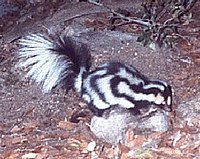
Photo from wikipedia
Abstract We analyzed phylogeographic patterns in the western spotted skunk, Spilogale gracilis Merriam, 1890 (Carnivora: Mephitidae) in relation to historical events associated with Pre‐Pleistocene Divergence (PPD) and Quaternary climate change… Click to show full abstract
Abstract We analyzed phylogeographic patterns in the western spotted skunk, Spilogale gracilis Merriam, 1890 (Carnivora: Mephitidae) in relation to historical events associated with Pre‐Pleistocene Divergence (PPD) and Quaternary climate change (QCC) using mitochondrial DNA from 97 individuals distributed across Western North America. Divergence times were generated using BEAST to estimate when isolation in putative refugia occurred. Patterns and timing of demographic expansion was performed using Bayesian skyline plot. Putative climatic refugia resulting from Quaternary climate change were identified using paleoecological niche modeling and divergence dates compared to major vicariant events associated with Pre‐Pleistocene conditions. We recovered three major mitochondrial clades corresponding to western North America (California, Baja, and across the Great Basin), east‐central North America (Texas, central Mexico, New Mexico), and southwestern Arizona/northwestern Mexico. Time to most recent common ancestor for S. gracilis occurred ~1.36 Ma. Divergence times for each major clade occurred between 0.25 and 0.12 Ma, with signature of population expansion occurring 0.15 and 0.10 Ma. Ecological niche models identified three potential climatic refugia during the Last Interglacial, (1) west coast of California and Oregon, (2) northwestern Mexico, and (3) southern Texas/northeastern Mexico as well as two refugia during the Last Glacial Maximum, (1) western USA and (2) southern Texas/northeastern Mexico. This study supports PPD in shaping species‐level diversity compared to QCC‐driven changes at the intraspecific level for Spilogale, similar to the patterns reported for other small mammals (e.g., rodents and bats). Phylogeographic patterns also appear to have been shaped by both habitat and river vicariance, especially across the desert southwest. Further, continuing climate change during the Holocene coupled with anthropogenic modifications during the Anthropocene appears to be removing both of these barriers to current dispersal of western spotted skunks.
Journal Title: Ecology and Evolution
Year Published: 2017
Link to full text (if available)
Share on Social Media: Sign Up to like & get
recommendations!